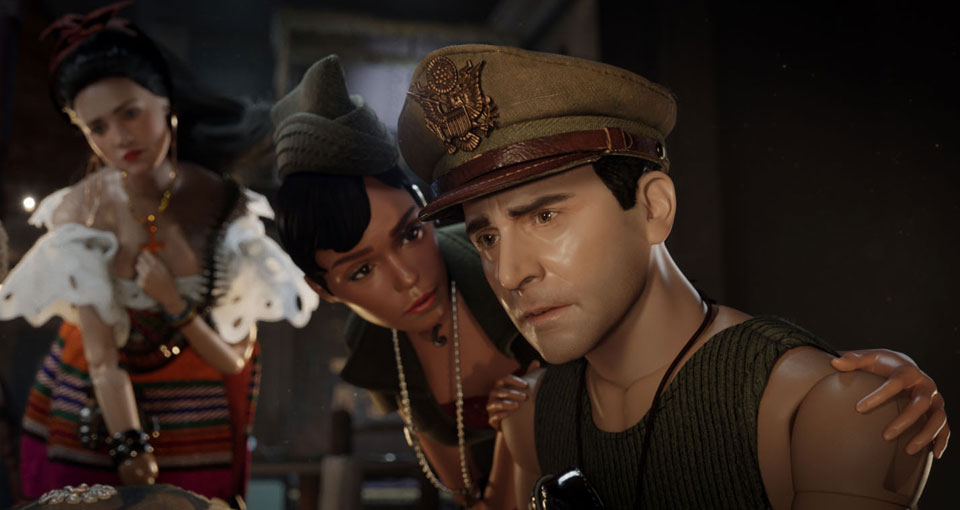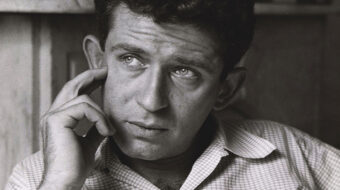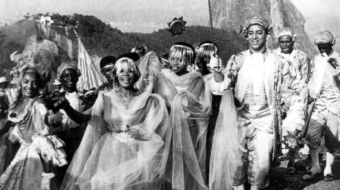
Inspired by a true story, director/co-writer Robert Zemeckis’s Welcome to Marwen is about how a hate crime perpetrated against real-life Mark Hoagancamp (Steve Carell) affects the illustrator. Suffering partial amnesia and no longer able to draw, Hoagancamp creates a miniature World War II Belgian village he names “Marwen” peopled by dolls, which he proceeds to photograph. The film has LGBTQ, PTSD, anti-Nazi and art therapy themes.
In 2010 Jeff Malmberg directed the documentary Marwencol about Hoagancamp’s saga which was very well received. It motivated Zemeckis to shoot a feature about this subject matter which is at times grim and gripping. How was Zemeckis going to give Malmberg’s 83-minute nonfiction film and Hoagancamp’s traumatic tale the Hollywood treatment?
Based on actual events and individuals, Zemeckis could have gone the docudrama path. Or, as with the 1975 documentary Grey Gardens about Jackie Kennedy’s mad relatives, Zemeckis could have played up an oddball angle, as a subsequent 2006 Broadway musical and 2009 HBO dramatization did.
Fortunately, Zemeckis, who has a history of cinematic innovation, chose another path. As with 1985’s Back to the Future, 1988’s Who Framed Roger Rabbit, 1992’s Death Becomes Her, 1994’s beloved Forrest Gump, et al, Zemeckis decided to innovate in terms of film form and special effects. To render Hoagancamp’s odyssey, Zemeckis creatively used motion-capture animation, which alternates with straightforward live-action sequences.
It’s beyond the scope of this review to explain this filmic technique also called “mo-cap” or “performance capture,” but essentially it is the recording of human thespians to then animate digital character models in 2D or 3D computer animation. Some examples of this process include, unsurprisingly, sci-fi and fantasy epics. Jar Jar Binks was rendered via motion capture in 1999’s Star Wars: Episode I—The Phantom Menace, which was also used in 2000’s Sinbad: Beyond the Veil of Mists, 2002’s The Lord of the Rings: The Two Towers, 2009’s Avatar and 2012’s The Hobbit: An Unexpected Journey. Zemeckis used this technology for 2007’s Beowulf and 2009’s A Christmas Carol.
In Welcome to Marwen this effect bestows the faces, expressions and of course voices of the actors such as Carell (a former Daily Show “correspondent”-turned-actor), German actress Diane Kruger (star of the 2017 anti-fascist film In the Fade), Leslie Mann (who’d co-starred with Carell in the 2005 comedy The 40-Year-Old Virgin), Mexican actress Eiza González (2017’s Baby Driver) and Janelle Monáe (2016’s Hidden Figures and Moonlight) onto the dolls that inhabit Hoagancamp’s Belgian hamlet and fantasies. Call it the “miracle at Marwen.”
Hoagancamp’s harem of living dolls and how he acts out through them is intriguing. What’s especially fascinating about Hoagancamp’s elaborate doll play is this art therapy angle, how—after being beaten within an inch of his life by neo-Nazi types because of his penchant for wearing high heels—Mark was able to find his way out of the darkness and back to sanity via Marwen. Not only that, but his photographs of Marwen have been exhibited at galleries, published in a book and, as noted, the inspiration for a documentary and narrative film.
Having said that, there is a maudlin aspect to Zemeckis’s account of a hate crime survivor. Admittedly, tackling dramas with tragic storylines can turn viewers off, particularly those seeking mindless entertainment in order to “get away from” their own everyday tragedies. Welcome to Marwen got a number of really bad reviews, including negative comments from some critics and others who attended the ArcLight Hollywood private screening I did.
Although it’s flawed, I commend Zemeckis, his cast and crew for not only taking on such daunting subject matter but for doing so in such an original way. Because Hoagancamp’s saga involved dolls as an important element, the use of motion-capture in Welcome to Marwen is not gimmicky—it is organic and flows naturally. All the more so because the film sensitively deals with psychiatric disorders, if not mental illness, and alternating from mo-cap to live action sequences cinematically expresses different states of mind. Welcome to Marwen may have the most extensive use of performance capture intercut with live actors in a non-sci fi or fantasy movie in film history.
Welcome to Marwen also features a number of good performances, led by Carell. Since his 1999-2015 stint on The Daily Show, Carell has proven himself to be adept at both comedy—as in 2006’s Little Miss Sunshine—and drama, as in 2014’s Foxcatcher, where he was extremely creepy. Merritt Wever has a sense of whimsy crossed by being down to Earth, as she was on Showtime’s Nurse Jackie, here depicting an in-the-flesh woman who tries to transcend Hoagancamp’s fantasies and fetishes, offering some real human connection and perhaps romance to a damaged soul.
In comparison to the highly original, psychologically daring Welcome to Marwen, Aquaman is a photocopy of endless superhero movies we’ve all seen countless times before (although perhaps not underwater). Welcome to Marwen may be an acquired taste and for more demanding, adventurous viewers, but I admired it for going beyond where most movies have gone before, both in terms of content and its highly creative film form. The 116-minute film opens Dec. 21. The trailer can be seen here.
L.A.-based reviewer/historian Ed Rampell is co-presenting a screening of Pasolini’s ‘The Gospel According to St. Matthew’ 7:00 pm, Thurs., Dec. 27 at the L.A. Workers Center, 1251 S. St. Andrews Place, L.A. 90019.












Comments